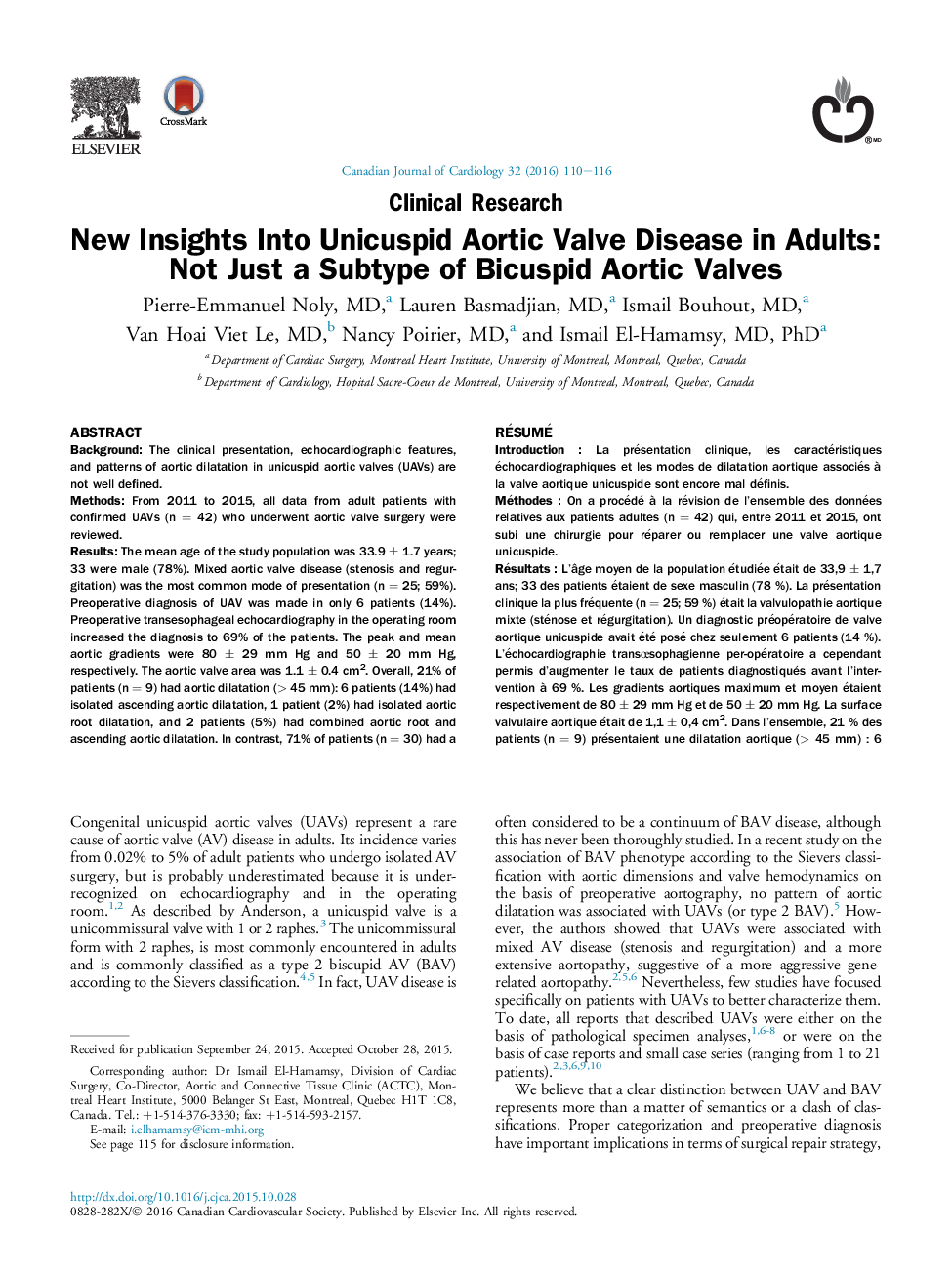| کد مقاله | کد نشریه | سال انتشار | مقاله انگلیسی | نسخه تمام متن |
|---|---|---|---|---|
| 2721696 | 1566489 | 2016 | 7 صفحه PDF | دانلود رایگان |
BackgroundThe clinical presentation, echocardiographic features, and patterns of aortic dilatation in unicuspid aortic valves (UAVs) are not well defined.MethodsFrom 2011 to 2015, all data from adult patients with confirmed UAVs (n = 42) who underwent aortic valve surgery were reviewed.ResultsThe mean age of the study population was 33.9 ± 1.7 years; 33 were male (78%). Mixed aortic valve disease (stenosis and regurgitation) was the most common mode of presentation (n = 25; 59%). Preoperative diagnosis of UAV was made in only 6 patients (14%). Preoperative transesophageal echocardiography in the operating room increased the diagnosis to 69% of the patients. The peak and mean aortic gradients were 80 ± 29 mm Hg and 50 ± 20 mm Hg, respectively. The aortic valve area was 1.1 ± 0.4 cm2. Overall, 21% of patients (n = 9) had aortic dilatation (> 45 mm): 6 patients (14%) had isolated ascending aortic dilatation, 1 patient (2%) had isolated aortic root dilatation, and 2 patients (5%) had combined aortic root and ascending aortic dilatation. In contrast, 71% of patients (n = 30) had a dilated aortic annulus (> 25 mm). Mean aortic diameters measured using transesophageal echocardiography were: aortic annulus: 25.8 ± 3.4 mm; sinus of Valsalva: 32.1 ± 5 mm, sinotubular junction: 28.1 ± 5 mm, and ascending aorta: 36.2 ± 5 mm. The valve was repaired using a bicuspidization technique in 8 patients (19%) and replaced using a Ross procedure in 34 patients (81%).ConclusionsUAVs remain significantly underdiagnosed in young adults with aortic valve disease. UAVs are associated with a distinct pattern of aortic dilatation, which is mainly present at the level of the aortic annulus. In a small proportion of patients, the valve can be surgically repaired.
RésuméIntroductionLa présentation clinique, les caractéristiques échocardiographiques et les modes de dilatation aortique associés à la valve aortique unicuspide sont encore mal définis.MéthodesOn a procédé à la révision de l'ensemble des données relatives aux patients adultes (n = 42) qui, entre 2011 et 2015, ont subi une chirurgie pour réparer ou remplacer une valve aortique unicuspide.RésultatsL’âge moyen de la population étudiée était de 33,9 ± 1,7 ans; 33 des patients étaient de sexe masculin (78 %). La présentation clinique la plus fréquente (n = 25; 59 %) était la valvulopathie aortique mixte (sténose et régurgitation). Un diagnostic préopératoire de valve aortique unicuspide avait été posé chez seulement 6 patients (14 %). L’échocardiographie transœsophagienne per-opératoire a cependant permis d'augmenter le taux de patients diagnostiqués avant l'intervention à 69 %. Les gradients aortiques maximum et moyen étaient respectivement de 80 ± 29 mm Hg et de 50 ± 20 mm Hg. La surface valvulaire aortique était de 1,1 ± 0,4 cm2. Dans l'ensemble, 21 % des patients (n = 9) présentaient une dilatation aortique (> 45 mm) : 6 patients (14 %) avaient une dilatation isolée de l'aorte ascendante; 1 patient (2 %) avait une dilatation isolée de la racine aortique et 2 patients (5 %) présentaient une dilatation de la racine aortique et de l'aorte ascendante. En contraste, 71 % des patients (n = 30) présentaient une dilatation de l'anneau aortique (> 25 mm). Les diamètres aortiques moyens mesurés par échocardiographie transœsophagienne étaient les suivants : anneau aortique : 25,8 ± 3,4 mm; sinus de Valsalva : 32,1 ± 5 mm, jonction sinotubulaire : 28,1 ± 5 mm, et aorte ascendante : 36,2 ± 5 mm. Huit patients (19 %) ont eu droit à une procédure de bicuspidisation de la valve, tandis que les 34 autres (81 %) ont subi un une procédure de Ross.ConclusionLa présence d'une valve aortique unicuspide demeure largement sous-diagnostiquée chez les jeunes adultes atteints de valvulopathie aortique. Cette malformation est pourtant associée à un mode distinctif de dilatation aortique, laquelle est surtout localisée au niveau de l'anneau aortique. Une réparation chirurgicale de la valve est possible chez un petit nombre de patients.
Journal: Canadian Journal of Cardiology - Volume 32, Issue 1, January 2016, Pages 110–116
